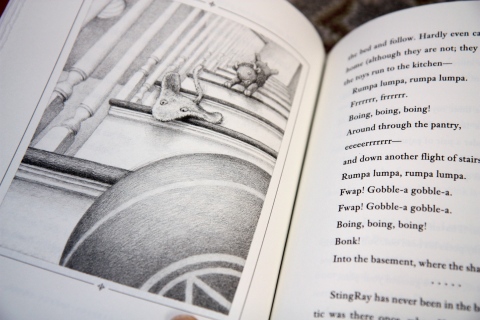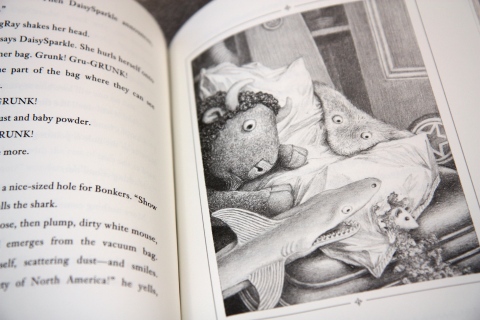Toys as Neurotic as Us
January 20, 2016 § 3 Comments
 If my children are playing nicely together (sound the trumpets!), chances are high that they’re in the company of stuffed animals. Once a stuffed animal enters our house and is given a name, it assumes an infallible place in JP and Emily’s communal imagination, albeit in an ever-changing litany of roles, from pet to circus performer. My kids crochet leashes for their animals; they bury them in boxes of peanuts and push them around the house; they string them from ceiling fans. They emerge from their respective bedrooms on weekend mornings, eyes partly open, with half a dozen animals tucked under their arms, ready for action.
If my children are playing nicely together (sound the trumpets!), chances are high that they’re in the company of stuffed animals. Once a stuffed animal enters our house and is given a name, it assumes an infallible place in JP and Emily’s communal imagination, albeit in an ever-changing litany of roles, from pet to circus performer. My kids crochet leashes for their animals; they bury them in boxes of peanuts and push them around the house; they string them from ceiling fans. They emerge from their respective bedrooms on weekend mornings, eyes partly open, with half a dozen animals tucked under their arms, ready for action.
Two tigers (Hobbies and Hobbies Jr.), a giant panda in a bellman uniform (Cookie), two doughnuts (Sprinkles and Sprinkles 2), and a monogrammed pillow (named, for whatever nonsensical reason when JP was two, Bag of Worms) are just a few of the soft friends that make frequent appearances in my children’s play. Still, as JP and Emily are quick to remind me, the life of a stuffed animal doesn’t begin and end at the hands of a child. The more exciting question is: what shenanigans do these toys get up to when their children are asleep or away?
Toys coming alive (when no one is looking) is the premise of Emily Jenkins’ hilarious and heartfelt chapter-book trilogy (Ages 7-9, younger if reading aloud), which begins with Toys Go Out, continues with Toy Dance Party, and concludes with Toys Come Home. (The third title is more accurately a “prequel,” although I’d still recommend reading it last, because my kids had a blast hearing the backstory on characters they’d come to love so much.)
The stories are told through the perspective of a small cast of toys, who live with a little girl in a cozy two-story house. The girl, whom the toys affectionately refer to as Honey, plays with her beloved toys as much as she can. She also “knows”—in that instinctual way children do—that the toys move around when she’s at school or on vacation or sleeping. She suspects this is why she sometimes comes upon them in different positions (say, sticking out of a snowdrift) than when she left them.
This is reading aloud at its most seductive.
Case in point: I gave the complete series—in hardcover, because Paul O. Zelinsky’s black-and-white drawings deserve nothing less—to my five year old for Christmas. Emily has been insistently vocal about her jealousy of the time I spend reading with JP after she goes to bed each night. “I want a chapter book that only you and I read!” Jenkins’ series seemed like the perfect answer to this appeal. I assumed my eight year old wouldn’t have too much interest in books whose covers display a stuffed buffalo (named Lumphy), a plush stingray (named StingRay), and a red rubber ball (named—huh?—Plastic).
The most pathetic sight I’ve ever seen might be my eight year old crouching outside his sister’s bedroom door, or wriggling his way under her bed, straining to hear every word of these stories as I read them aloud. After a few days of this, Emily and I decided to put JP out of his misery. We started the series over again in our familiar stance: the five year old on one side of me, the eight year old on the other.
And no wonder. Jenkins’ writing is so delicate, her wit at times so refined, that her stories easily captivate the imagination of the older child as much as the younger one (especially those obsessed, as mine certainly are, with their stuffed toys).
But it’s more than that. These books display some of the best characterization I’ve ever come across in young children’s literature. Jenkins gives her characters such depth of feeling, such clear and multi-faceted personalities, that we feel like we know them as well as we know ourselves. These are characters who harbor the same hopes and fears and questions and neuroses that all of us (I mean, all of our children) do.
There’s Stingray, de facto leader of the group, who thinks she knows everything and pontificates straight out of her backside (“You’re not a grown-up until you’re at least eight…When you’re eight you can drive a limousine…and brush your teeth without being reminded…and you have lots of money to buy all the chocolate you want.”) Over time, we come to recognize that StingRay’s bossiness stems from a deep insecurity of falling out of favor with the little girl. Of becoming unloved.
There’s Lumphy: the innocent, sensitive, prone-to-motion-sickness bison, who prefers to think the best of people and wants only to be noticed in return. Who, again and again, surprises himself by his bravery at the most critical times.
There’s bouncy Plastic who, when she’s not having an identity crisis about her name, is at once the most exuberant and levelheaded of the bunch. Her natural curiosity about life and self-taught ability to read makes her a fairly accurate reporter on animals, plants, and weather.
Some of my kids’ favorite characters make up the supporting cast. There’s TukTuk the towel, an authority on all things hygiene. There’s Frank the Washing Machine, who lives in the creepy basement and finds a welcome audience for his serenades in the “greasy buffalo” who frequents his wash cycles. And then there’s the one-eared Sheep, a third generation stuffed animal, whose amassed wisdom about the way the world works often gets lost in his propensity to nod off every few minutes.
Taken as a whole, these three chapter books read like a mini primer on how to navigate relationships. On how to be a child trying to connect with the world. On what to do and what not to do and what to do when you get it wrong.
Have you ever felt jealous? Then you’ll understand why the toys stage a glitter-glue coup on the shiny new Barbies, whom they believe are getting too much of Honey’s attention.
Afraid of the New, the Strange, the Different? When a white rubber shark shows up among Honey’s birthday presents, the toys promptly stuff garbage down its throat in an effort to keep it from eating them (turns out she only wants to start a Paper Chewing Club).
Abandonment issues? Check. Especially when Honey leaves the toys at home during winter vacation, and a day feels like a week feels like a month feels like an eternity. (To add insult to injury, Honey has taken the Barbies with her on vacation—“Those Barbie dolls who say nothing at all!”)
Have you ever made someone feel bad about himself because you were feeling bad about yourself? Have you ever made up something because you were trying to impress someone? Have you ever acted like you didn’t care when deep down you cared so much? All this happens and with great frequency.
But there’s also ample forgiveness, both of each other and of themselves. The toys learn from one another. They constantly have each other’s backs (one chapter is titled “You Can Puke On Me”). And many of the most delightful scenes in the books come when the toys are working together towards a common goal: making a birthday present for Honey; evading a hellacious cat named Pumpkinfacehead; or rescuing StingRay, after she tries to prove that she’s a real fish and nearly drowns in the bathtub (StingRay is humiliated. She almost wishes they hadn’t found her, it is so embarrassing to be a soggy plush sinker fish. And yet, she is very glad they did.)
As Honey gets older, the time she spends with her toys will get shorter. And yet, when the trilogy ends, the toys are beginning to realize that their real loyalty lies to each other. Friendships have their ups and downs, but they also make life every bit worth fighting for. Lumphy, StingRay, and Plastic may still have zillions of questions about how the world works, but chances are they’ll be okay if they stick together.
I only hope my children’s stuffed toys find a similar happy ending someday.
But wait! If your kids aren’t old enough for this chapter book series—or even if they are—Emily Jenkins recently wrote a spin-off PICTURE BOOK, titled Toys Meet Snow. It’s every bit as wonderful as the others (albeit much sparser) and has the added benefit of showcasing Paul O. Zelinsky’s illustrations of these beloved characters in full color. After you read it, you’ll understand why my children have been talking about the “tiny ballerinas that are going to dance down from the sky” in this weekend’s approaching blizzard.
Did you enjoy this post? Make sure you don’t miss any! Enter your email on the right hand side of my homepage, and you’ll receive a new post in your inbox every time.
Amazon.com affiliate links are provided mainly for ease and reference–although I prefer that we all shop local when we can!
Related
Tagged: animals, children's stories about snow, Emily Jenkins, forgiveness, friendship in children's stories, humor, jealousy in chidren's stories, kids navigating feelings, Paul O. Zelinsky, picture book, read-aloud chapter books, separation anxiety, theme of kindness in children's books, toys coming to life in chidlren's stories, winter






Putting these on my list- thank you!
Yay! I hope you enjoy them as much as we did!
[…] Jenkins and illustrated by Paul O. Zelinsky (both of whom will forever have my heart because of these), All-of-a-Kind Family Hanukkah (Ages 3-7) does the seemingly impossible: it perfectly channels the […]